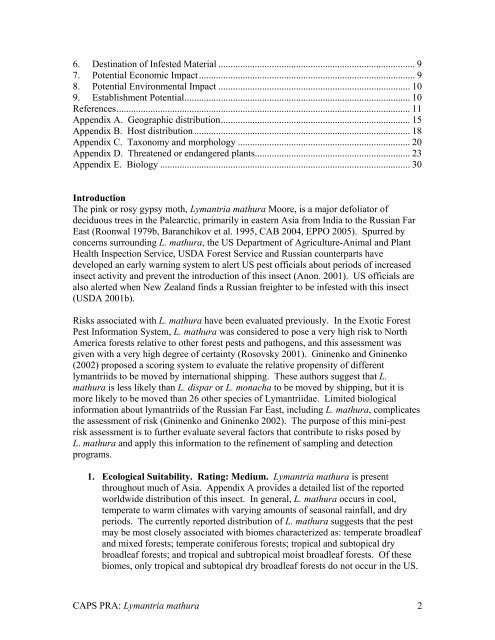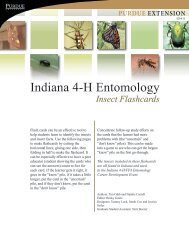Pink Gypsy Moth - aphis - US Department of Agriculture
Pink Gypsy Moth - aphis - US Department of Agriculture
Pink Gypsy Moth - aphis - US Department of Agriculture
You also want an ePaper? Increase the reach of your titles
YUMPU automatically turns print PDFs into web optimized ePapers that Google loves.
6. Destination <strong>of</strong> Infested Material ................................................................................. 9<br />
7. Potential Economic Impact......................................................................................... 9<br />
8. Potential Environmental Impact ............................................................................... 10<br />
9. Establishment Potential............................................................................................. 10<br />
References......................................................................................................................... 11<br />
Appendix A. Geographic distribution.............................................................................. 15<br />
Appendix B. Host distribution ......................................................................................... 18<br />
Appendix C. Taxonomy and morphology ....................................................................... 20<br />
Appendix D. Threatened or endangered plants................................................................ 23<br />
Appendix E. Biology ....................................................................................................... 30<br />
Introduction<br />
The pink or rosy gypsy moth, Lymantria mathura Moore, is a major defoliator <strong>of</strong><br />
deciduous trees in the Palearctic, primarily in eastern Asia from India to the Russian Far<br />
East (Roonwal 1979b, Baranchikov et al. 1995, CAB 2004, EPPO 2005). Spurred by<br />
concerns surrounding L. mathura, the <strong>US</strong> <strong>Department</strong> <strong>of</strong> <strong>Agriculture</strong>-Animal and Plant<br />
Health Inspection Service, <strong>US</strong>DA Forest Service and Russian counterparts have<br />
developed an early warning system to alert <strong>US</strong> pest <strong>of</strong>ficials about periods <strong>of</strong> increased<br />
insect activity and prevent the introduction <strong>of</strong> this insect (Anon. 2001). <strong>US</strong> <strong>of</strong>ficials are<br />
also alerted when New Zealand finds a Russian freighter to be infested with this insect<br />
(<strong>US</strong>DA 2001b).<br />
Risks associated with L. mathura have been evaluated previously. In the Exotic Forest<br />
Pest Information System, L. mathura was considered to pose a very high risk to North<br />
America forests relative to other forest pests and pathogens, and this assessment was<br />
given with a very high degree <strong>of</strong> certainty (Rosovsky 2001). Gninenko and Gninenko<br />
(2002) proposed a scoring system to evaluate the relative propensity <strong>of</strong> different<br />
lymantriids to be moved by international shipping. These authors suggest that L.<br />
mathura is less likely than L. dispar or L. monacha to be moved by shipping, but it is<br />
more likely to be moved than 26 other species <strong>of</strong> Lymantriidae. Limited biological<br />
information about lymantriids <strong>of</strong> the Russian Far East, including L. mathura, complicates<br />
the assessment <strong>of</strong> risk (Gninenko and Gninenko 2002). The purpose <strong>of</strong> this mini-pest<br />
risk assessment is to further evaluate several factors that contribute to risks posed by<br />
L. mathura and apply this information to the refinement <strong>of</strong> sampling and detection<br />
programs.<br />
1. Ecological Suitability. Rating: Medium. Lymantria mathura is present<br />
throughout much <strong>of</strong> Asia. Appendix A provides a detailed list <strong>of</strong> the reported<br />
worldwide distribution <strong>of</strong> this insect. In general, L. mathura occurs in cool,<br />
temperate to warm climates with varying amounts <strong>of</strong> seasonal rainfall, and dry<br />
periods. The currently reported distribution <strong>of</strong> L. mathura suggests that the pest<br />
may be most closely associated with biomes characterized as: temperate broadleaf<br />
and mixed forests; temperate coniferous forests; tropical and subtopical dry<br />
broadleaf forests; and tropical and subtropical moist broadleaf forests. Of these<br />
biomes, only tropical and subtopical dry broadleaf forests do not occur in the <strong>US</strong>.<br />
CAPS PRA: Lymantria mathura 2
















